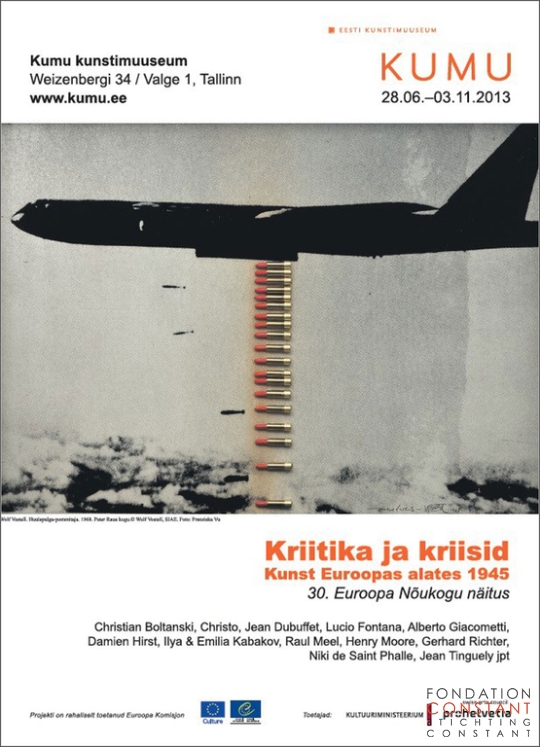Image


1679
On Friday, 28 June, the large-scale international exhibition Critique and Crises. Art in Europe since 1945 will open at the Kumu Art Museum. Within the framework of the exhibition, the works of almost a hundred great names of European avant-garde art from both sides of the Iron Curtain will be brought to Estonia for the first time.
The Cold War, which followed World War II, fundamentally impacted Europe's political and social landscape and it continues to do so until the present day. Yet many of the attitudes that remain from the Cold War are anachronistic and this exhibition proves this. For the first time, Critique and Crises examines the art from that period as an integral whole, without categorising it ideologically, geographically or politically into two separate camps: the East and the West. The exhibition includes works by the Estonian artists Raul Meel and Kaljo Põllu, alongside such artists as Damien Hirst, Christian Boltanski, Anselm Kiefer, Jean Tinguely, Alberto Giacometti, Niki de Saint Phalle, Henry Moore, Volf Vostell, Christo, Ilja Kabakov, Gerhard Richter, Lucio Fontana and many others.
The roots of the political situation of the Cold War era can be found in the 18th-century Age of Enlightenment. The Enlightenment led to an unceasing process of criticism and crises which resulted in both ruinous and happy times. Aesthetic radicalism, a term that can be used to describe the avant-garde art of the Cold War era, was one of the most important positions for criticising the social and political situation and for highlighting the crises.
Critique and Crises. Art in Europe since 1945, which is a collaborative project initiated and curated by the German Historical Museum, opened in Berlin last autumn. The project, which is travelling to its last stop in Tallinn from Milan, is the 30th Council of Europe Art Exhibition.
The exhibition is accompanied by the thorough English-language catalogue The Desire for Freedom. Art in Europe since 1945.
The works of the following artists are included in the exhibition:
John Latham, Ian Hamilton Finlay, Jannis Kounellis, Oskar Hansen, Miklós Erdély, Yinka Shonibare, Marcel Broodthaers, Mangelos, Ilja Kabakov, Constant, Erró, Nil Yalter, Stephan Balkenhol, Christian Boltanski, Armando, Damien Hirst, Günther Uecker, Anselm Kiefer, György Kovásznai, Dóra Maurer, Henry Moore, Jane & Louise Wilson, Nikita Kadan, Sabina Šihlinskaja, Gerhard Rühm, Niki de Saint Phalle, Nikos Engonopoulos, Jean Tinguely, Fritz Winter, Mária Bartuszová, Richard Hamilton, Boriss Mihhailov, Edi Hila, Wolf Vostell, Emilio Vedova, Konrad Klapheck, Raymond Hains, Sanja Iveković, Dan Perjovschi, Kaljo Põllu, Tamás St. Auby, Emil Schumacher, KwieKulik, Mladen Stilinović, Natalia LL, Gerhard Richter, Andreas Gursky, Peter Blake, Blue Noses, Milan Kunc, Aurora Reinhard, Sylvie Fleury, VALIE EXPORT, Karel Malich, Arman, Bruno Gironcoli, Svein Flygari Johansen, Christo, Antonio Calderara, Tjebbe Beekman, Absalon, Iced Architects, Chris Reinecke, Jordi Colomer, Paweł Althamer, Miodrag Mića Popović, Enzo Cucchi, Lucio Fontana, Zdenĕk Urbánek, Vladimír Fuka, Jiří Kolář, Raul Meel, Július Koller, Kvetoslava Fulierová, Neša Paripović, Ulrike Rosenbach, Jean Dubuffet, Roman Opałka, Pilar Albarracín, Antony Gormley, Alberto Giacometti, Erwin Wurm, Nam June Paik, Carlfriedrich Claus, Yüksel Arslan, Vladimir Mitrev, The Blue Soup Group, Yves Klein.
Exhibition curators: Monika Flacke, Henry Meyric Hughes and Ulrike Schmiegelt.
Exhibition designers: Terje Luure and Urmas Luure.
No related items available
No related items available
No related items available
No related items available
No related items available
| Title | Year |
|---|---|
| Twee torens | 1959 |
No related items available
No related items available